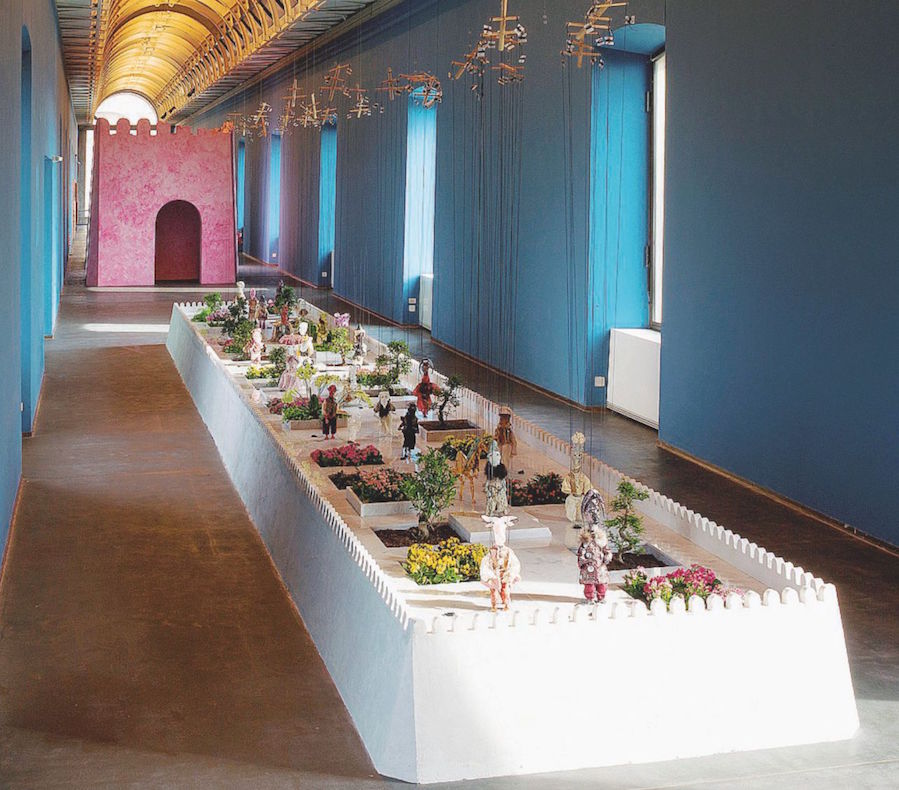
Wael Shawky
a cura di Carolyn Christov-Bakargiev e Marcella Beccaria
Fino al 5 febbraio 2017 – Castello di Rivoli
La retrospettiva di Wael Shawky (Alessandria d’Egitto, 1971), allestita al Castello di Rivoli, presenta una serie di opere filmiche, sculture e nuovi altorilievi lignei ispirati alla storia delle Crociate, narrata dal punto di vista degli arabi anziché degli europei.
L‘artista trasforma lo spazio della Manica Lunga, le cui pareti sono state dipinte di blu, in un ambiente scenografico e spettacolare. Il percorso espositivo, che inizia con i nuovi altorilievi, si snoda attraverso una costruzione all’interno della quale è proiettato Cabaret Crusades: The Horror Show File (2010) per poi proseguire verso un giardino che include ventisei sculture. Si giunge quindi a un’altra costruzione che rievoca un minareto al cui interno è proiettato Cabaret Crusades: The Path to Cairo (2012). L’allestimento prosegue con una serie di fotografie di marionette e si conclude con il terzo video della trilogia, The Secrets of Karbala (2015). “I visitatori – scrive Marcella Beccaria – vengono trasportati in un passato remoto i cui echi sono però riconoscibili nel nostro instabile presente di guerre mediorientali e nuove incertezze”.
Ispirata a fonti medievali islamiche quali Usama Ibn Munqidh e Ibn al-Qalànisi – oltre a Le Crociate viste dagli Arabi (1983), dello storico libanese Amin Maalouf – Cabaret Crusades si sofferma sulla storia delle campagne militari volute dalla Chiesa in Terra Santa.
L’artista inizia la narrazione con le prime Crociate, dal 1096 al 1099, messe in scena nel primo capitolo di Cabaret Crusades: The Horror Show File. Prosegue con la storia degli eventi tra la Prima e la Seconda Crociata, dal 1099 al 1145, rappresentata in Cabaret Crusades: The Path to Cairo. Queste opere scavalcano le più tradizionali nozioni relative allo scontro di civiltà tra mondo occidentale e culture islamiche. L’utilizzo di marionette al posto di attori veri e propri, permette alla trilogia di mantenere un tono magico, apparentemente discordante con l’argomento violento e macabro descritto. Shawky si è servito di antichi burattini del Settecento provenienti dalla collezione Lupi di Torino per il primo film e di marionette in ceramica realizzate appositamente per il secondo.
The Secrets of Karbala è l’ultimo capitolo della trilogia e vede l’uso di marionette in vetro di Murano nelle quali le sembianze dei personaggi intrecciano forme umane, animali e memorie di antiche maschere africane. L’opera presenta scorci della Battaglia di Kerbela (680), il principale e tragico evento che portò alla tuttora esistente divisione tra Islam sciita e sunnita. La narrazione termina con la presa di Costantinopoli da parte dei Crociati nel 1204.
La trilogia affronta il problema della storia e delle vicende umane travolte da ambizione e rivalità, da tradimenti e violenze.

Kerry James Marshall: Mastry
October 25, 2016–January 29, 2017
The Met Breuer, 3rd and 4th floors
The largest museum retrospective to date of the work of American artist Kerry James Marshall (born 1955) will open this October at The Met Breuer as a cornerstone of its inaugural season. Encompassing nearly 80 works—including 72 paintings—that span the artist’s remarkable 35-year career, this major monographic exhibition reveals Marshall’s practice to be a complex and compelling one that synthesizes a wide range of pictorial traditions to counter stereotypical representations of black people in society and reassert the place of the black figure within the canon of Western painting.
Kerry James Marshall: Mastry will be complemented by the concurrent exhibition Kerry James Marshall Selects, curated by the artist. Marshall will draw some 40 works from The Met collection, ranging from the Northern Renaissance to French post-Impressionism, and from African masks to American photography of the 1950s and ‘60s, underscoring the global and historical nature of the influences that are predominant in his practice.
Born before the passage of the Civil Rights Act in Birmingham, Alabama, and witness to the Watts rebellion in 1965, Marshall has long been an inspired and imaginative chronicler of the African American experience. He is known for his large-scale narrative history paintings featuring black figures—defiant assertions of blackness in a medium in which African Americans have long been invisible—and his exploration of art history covers a broad temporal swath stretching from the Renaissance to 20th-century American abstraction. Marshall critically examines and reworks the Western canon through its most archetypal forms: the historical tableau, landscape and genre painting, and portraiture. His work also touches upon vernacular forms such as the muralist tradition and the comic book in order to address and correct, in his words, the “vacuum in the image bank” and to make the invisible visible.
The exhibition’s title is a play on words referencing Marshall’s comics-inspired Rythm Mastr series, and the works to be included range from the early and iconic—such as A Portrait of the Artist as a Shadow of His Former Self (1980) and Invisible Man (1986)—to his newest revisions of traditional history painting. One of these major, recent works—Untitled (Studio) (2014), a monumental picture depicting an artist’s workspace—was recently acquired by The Met. A veritable catalogue of the genres of painting, it combines still life, portraiture, and landscape with trompe l’oeil and abstraction, and includes many references to the Old Masters. The exhibition will also reunite the five paintings of Marshall’s Garden Project series—pictures from the mid-1990s that serve to complicate the idea of public housing as bleak or desolate—for the first time in 20 years. Included among these is these is Watts 1963, which depicts the artist and his siblings at play outside Nickerson Gardens, the projects in Watts where the 8-year-old Marshall and his family lived when they first moved to California in 1963. Pages from the Rythm Mastr project, ongoing since 1999, are also featured in the exhibition. These graphic novel panels highlight Marshall’s interest in comics as a vehicle for exploring cultural phenomena, embodied by his band of black superheroes and his incorporation of African American vernacular.











